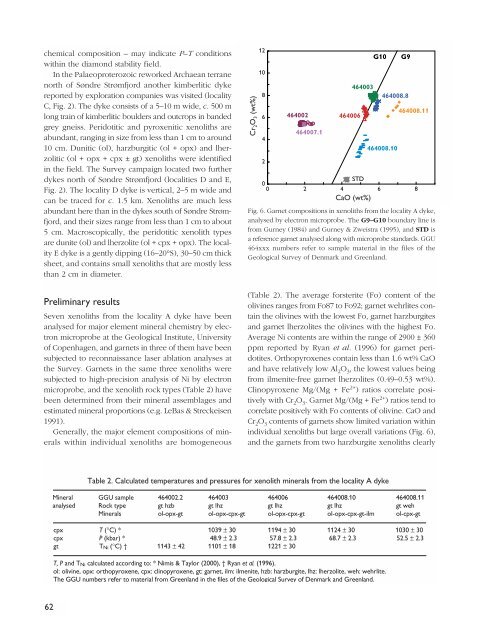Review of Greenland Avtivities 2001 - Geus
Review of Greenland Avtivities 2001 - Geus
Review of Greenland Avtivities 2001 - Geus
You also want an ePaper? Increase the reach of your titles
YUMPU automatically turns print PDFs into web optimized ePapers that Google loves.
chemical composition – may indicate P–T conditions<br />
within the diamond stability field.<br />
In the Palaeoproterozoic reworked Archaean terrane<br />
north <strong>of</strong> Søndre Strømfjord another kimberlitic dyke<br />
reported by exploration companies was visited (locality<br />
C, Fig. 2). The dyke consists <strong>of</strong> a 5–10 m wide, c. 500 m<br />
long train <strong>of</strong> kimberlitic boulders and outcrops in banded<br />
grey gneiss. Peridotitic and pyroxenitic xenoliths are<br />
abundant, ranging in size from less than 1 cm to around<br />
10 cm. Dunitic (ol), harzburgitic (ol + opx) and lherzolitic<br />
(ol + opx + cpx ± gt) xenoliths were identified<br />
in the field. The Survey campaign located two further<br />
dykes north <strong>of</strong> Søndre Strømfjord (localities D and E,<br />
Fig. 2). The locality D dyke is vertical, 2–5 m wide and<br />
can be traced for c. 1.5 km. Xenoliths are much less<br />
abundant here than in the dykes south <strong>of</strong> Søndre Strømfjord,<br />
and their sizes range from less than 1 cm to about<br />
5 cm. Macroscopically, the peridotitic xenolith types<br />
are dunite (ol) and lherzolite (ol + cpx + opx). The locality<br />
E dyke is a gently dipping (16–20°S), 30–50 cm thick<br />
sheet, and contains small xenoliths that are mostly less<br />
than 2 cm in diameter.<br />
Preliminary results<br />
Seven xenoliths from the locality A dyke have been<br />
analysed for major element mineral chemistry by electron<br />
microprobe at the Geological Institute, University<br />
<strong>of</strong> Copenhagen, and garnets in three <strong>of</strong> them have been<br />
subjected to reconnaissance laser ablation analyses at<br />
the Survey. Garnets in the same three xenoliths were<br />
subjected to high-precision analysis <strong>of</strong> Ni by electron<br />
microprobe, and the xenolith rock types (Table 2) have<br />
been determined from their mineral assemblages and<br />
estimated mineral proportions (e.g. LeBas & Streckeisen<br />
1991).<br />
Generally, the major element compositions <strong>of</strong> minerals<br />
within individual xenoliths are homogeneous<br />
Cr 2 O 3 (wt%)<br />
12<br />
10<br />
8<br />
6<br />
4<br />
2<br />
0<br />
464002<br />
464007.1<br />
464006<br />
464003<br />
STD<br />
G10<br />
464008.8<br />
464008.10<br />
464008.11<br />
0 2 4 6 8<br />
CaO (wt%)<br />
Fig. 6. Garnet compositions in xenoliths from the locality A dyke,<br />
analysed by electron microprobe. The G9–G10 boundary line is<br />
from Gurney (1984) and Gurney & Zweistra (1995), and STD is<br />
a reference garnet analysed along with microprobe standards. GGU<br />
464xxx numbers refer to sample material in the files <strong>of</strong> the<br />
Geological Survey <strong>of</strong> Denmark and <strong>Greenland</strong>.<br />
(Table 2). The average forsterite (Fo) content <strong>of</strong> the<br />
olivines ranges from Fo87 to Fo92; garnet wehrlites contain<br />
the olivines with the lowest Fo, garnet harzburgites<br />
and garnet lherzolites the olivines with the highest Fo.<br />
Average Ni contents are within the range <strong>of</strong> 2900 ± 360<br />
ppm reported by Ryan et al. (1996) for garnet peridotites.<br />
Orthopyroxenes contain less than 1.6 wt% CaO<br />
and have relatively low Al 2 O 3 , the lowest values being<br />
from ilmenite-free garnet lherzolites (0.49–0.53 wt%).<br />
Clinopyroxene Mg/(Mg + Fe 2+ ) ratios correlate positively<br />
with Cr 2 O 3 . Garnet Mg/(Mg + Fe 2+ ) ratios tend to<br />
correlate positively with Fo contents <strong>of</strong> olivine. CaO and<br />
Cr 2 O 3 contents <strong>of</strong> garnets show limited variation within<br />
individual xenoliths but large overall variations (Fig. 6),<br />
and the garnets from two harzburgite xenoliths clearly<br />
G9<br />
Table 2. Calculated temperatures and pressures for xenolith minerals from the locality A dyke<br />
Mineral GGU sample 464002.2 464003 464006 464008.10 464008.11<br />
analysed Rock type gt hzb gt lhz gt lhz gt lhz gt weh<br />
Minerals ol-opx-gt ol-opx-cpx-gt ol-opx-cpx-gt ol-opx-cpx-gt-ilm ol-cpx-gt<br />
cpx T (°C) * 1039 ± 30 1194 ± 30 1124 ± 30 1030 ± 30<br />
cpx P (kbar) * 48.9 ± 2.3 57.8 ± 2.3 68.7 ± 2.3 52.5 ± 2.3<br />
gt T Ni (°C) † 1143 ± 42 1101 ± 18 1221 ± 30<br />
T, P and T Ni calculated according to: * Nimis & Taylor (2000), † Ryan et al. (1996).<br />
ol: olivine, opx: orthopyroxene, cpx: clinopyroxene, gt: garnet, ilm: ilmenite, hzb: harzburgite, lhz: lherzolite, weh: wehrlite.<br />
The GGU numbers refer to material from <strong>Greenland</strong> in the files <strong>of</strong> the Geological Survey <strong>of</strong> Denmark and <strong>Greenland</strong>.<br />
62

















